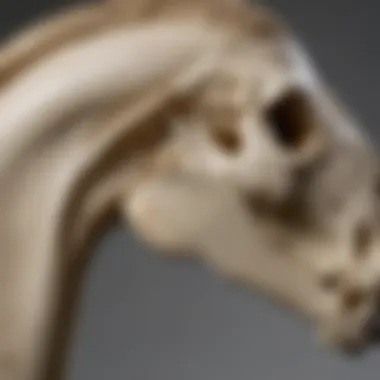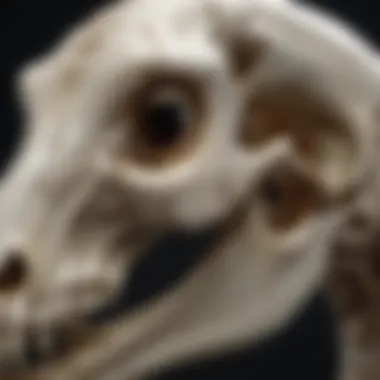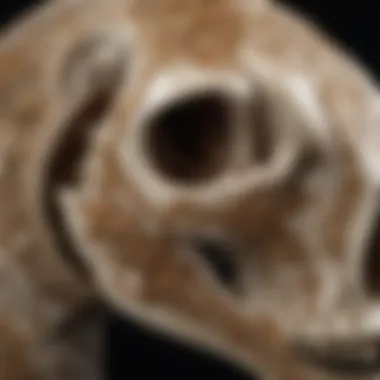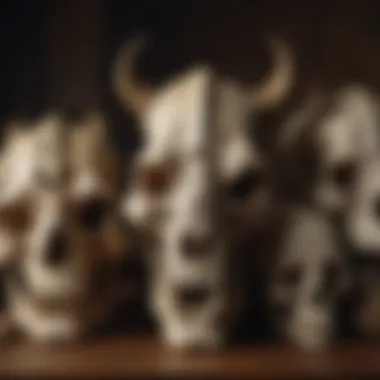Unveiling the Enigmatic World of Equine Skulls: A Rare Gem for Discerning Collectors


This article delves into the intriguing realm of horse skulls, exploring their significance and allure to collectors. From the anatomy to the cultural symbolism, the horse skull serves as a unique and sought-after artifact. Join us on a journey through the history and value of horse skulls in the realm of collection and preservation.
Rock and Fossil Identification
As we delve into the fascinating world of horse skulls, understanding the types of rocks and fossils associated with these relics is crucial. Fossils of horse skulls are typically found in sedimentary rocks, such as limestone or shale. Characteristics to look for include the distinct shape and size of the skull, as well as any remnants of teeth or bone structures. To aid in identification, collectors can utilize tools like brushes, chisels, and magnifying glasses to carefully unearth and examine these precious finds.
Collecting Tips and Techniques
For collectors eager to add horse skulls to their assemblage, best practices must be observed. Locating prime collecting sites often involves researching areas with known horse populations or historical significance. Once on-site, safely extracting specimens requires gentle handling and meticulous excavation to avoid damaging the delicate structures. Utilizing proper tools and techniques, collectors can ensure that their acquisitions are preserved in optimal condition for display.
Preservation and Display
Preserving horse skulls for posterity is an art form in itself. Techniques such as cleaning with brushes and mild detergents, followed by controlled drying and storage, are essential for longevity. Properly storing these artifacts involves protecting them from external elements like humidity and direct sunlight. Creative display ideas range from elegant mounting on stands to incorporation into themed collections, offering viewers a deeper appreciation for the historical and aesthetic value of horse skulls.
Geological Insights
Delving into the geological context of horse skull discoveries unveils a rich tapestry of natural history. These artifacts are often found in regions with distinctive geological formations, shedding light on past ecosystems and climate conditions. Throughout history, notable discoveries of horse skulls have provided valuable insights into evolution and genetic diversity. By examining these geological insights, collectors can appreciate the interconnectedness of earth sciences and the fascinating allure of horse skulls.
Introduction
In the intriguing realm of horse skulls, there lies a world drenched in mystery and allure that captivates collectors and enthusiasts alike. The horse skull, a rare find shrouded in enigma, serves as a captivating glimpse into the past, echoing tales of evolution, cultural symbolism, and artistic admiration. This article embarks on a journey through the intricate intricacies of horse skulls, shedding light on their historical, anatomical, and symbolic significance, unveiling the layers of fascination that make them highly coveted treasures among collectors and connoisseurs.
Unveiling the Enigma
The Mystique of Horse Skulls
Delving into 'The Mystique of Horse Skulls,' we unravel the essence of intrigue that surrounds these unique artifacts. The allure of horse skulls lies in their symbolic resonance, representing strength, nobility, and the timeless link between man and beast. Collectors are drawn to the enigmatic aura exuded by these skulls, each telling a silent story of a bygone era. The detailed anatomy, from the elegant curvature of the cranium to the intricate dental formations, adds to their mystique, making them a valuable addition to any collection.


Evolutionary Significance
Exploring the 'Evolutionary Significance' of horse skulls, we uncover the deep-rooted history embedded within these skeletal structures. These skulls serve as tangible evidence of the evolutionary journey of horses, reflecting adaptations and changes over millennia. Understanding the evolutionary significance not only enriches our appreciation for these specimens but also provides a profound insight into the interconnectedness of life on Earth, making them a compelling focal point for collectors seeking to connect with the past.
Collecting Treasures
Rarity and Exclusivity
The aspect of 'Rarity and Exclusivity' adds a layer of allure to horse skulls, making them highly sought-after treasures among collectors. The limited availability of authentic specimens heightens their value, turning them into prized possessions for those with a discerning eye for unique artifacts. The exclusivity of owning a horse skull contributes to its appeal, elevating it from a mere collectible to a symbol of status and appreciation for the rare and exceptional.
Artistic and Cultural Value
Delving into the 'Artistic and Cultural Value' of horse skulls unveils a world where beauty intertwines with tradition. Beyond their anatomical intricacies, these skulls hold artistic merit, often adorned with intricate engravings or used as symbolic elements in cultural practices. The fusion of artistry and cultural symbolism imbues horse skulls with a profound heritage, transcending their physical form to evoke emotions and narratives from times long past.
Exploring Horse Skulls
In this article, the section on Exploring Horse Skulls serves as a pivotal exploration into the intricate realm of equine anatomy and cultural significance within the context of collection and preservation. This section immerses the reader in the detailed examination of horse skulls, shedding light on their unique allure and characteristics that make them highly coveted by rock and fossil collectors.
Anatomy and Structure
Cranial Features
Diving into the cranial features of horse skulls reveals a fascinating study of the unique skeletal structure inherent in these specimens. The cranial features encompass the intricate bone arrangement, including the frontal bones, parietal bones, and occipital bones, offering a comprehensive understanding of the skull's anatomy. This detailed exploration allows collectors to appreciate the complexity and beauty of horse skulls, making them coveted pieces for enthusiasts seeking to grasp the essence of equine morphology. Understanding the cranial features provides valuable insights into the evolution and adaptation of horses, making them a significant element in the narrative of horse skull collection.
Dental Characteristics
The dental characteristics of horse skulls constitute a critical component that adds depth to their allure in the world of collection and preservation. Focusing on the dental structure, collectors can examine the intricacies of incisors, canines, premolars, and molars, unveiling a wealth of information regarding equine dentition and its role in the animal's life cycle. The dental characteristics not only showcase the functional aspects of the teeth but also contribute to the overall aesthetic appeal of horse skulls, making them sought-after items for individuals with a passion for paleontology and natural history. Discerning collectors appreciate the detailed dental features as they signify the unique attributes of each specimen, enriching the stories embedded within these archaeological treasures.
Historical Significance


Archaeological Discoveries
The historical significance of horse skulls is reinforced through the lens of archaeological discoveries, unveiling a tapestry of narratives that traverse centuries of human civilization. Unearthing horse skulls in archaeological sites provides valuable insights into the relationship between humans and horses throughout history, shedding light on practices such as burial rituals, sacrifices, and ceremonial offerings involving these majestic animals. Each archaeological discovery offers a glimpse into ancient cultures and their reverence for horses, highlighting the symbolic value attached to these revered creatures. Collectors embarking on the journey of horse skull acquisition delve into a realm rich with historical context and archaeological intrigue, transcending time to connect with the legacy of horse-human interaction.
Cultural Practices
Delving into the cultural practices associated with horse skulls unveils a mosaic of traditions, beliefs, and rituals that have permeated various societies across the globe. From Native American tribes incorporating horse skulls in spiritual ceremonies to European folklore depicting horses as symbols of strength and nobility, cultural practices illuminate the deep-rooted connections between humans and horses. The incorporation of horse skulls in artistic expressions, religious rites, and cultural symbolism underscores their significance as more than mere anatomical specimens, elevating them to relics of cultural heritage and mythological reverence. Rock and fossil collectors who appreciate the cultural depth embedded within horse skulls find themselves drawn to their allure, recognizing them as tokens of historical significance and cultural richness.
Acquiring a Horse Skull
In this detailed exploration of the world of horse skulls, the section on Acquiring a Horse Skull holds a crucial position. Acquiring a horse skull is not merely a transaction but a journey into history, culture, and ethical considerations when considering adding such a unique specimen to one's collection. For collectors, the acquisition process goes beyond just obtaining an item; it involves understanding the implications, responsibilities, and reverence attached to such a rare find. The significance of Acquiring a Horse Skull lies in the intricate balance between passion for collecting and the ethical considerations that must be carefully navigated.
Ethical Considerations
Sourcing and Legality
Delving into the realm of Sourcing and Legality sheds light on the ethical foundation of acquiring a horse skull as a collector. The rigorous adherence to legal channels ensures that each horse skull obtained is done so ethically and responsibly. This meticulous process not only guarantees the authenticity of the artifact but also contributes to the sustainability and preservation of equine history. The unique feature of Sourcing and Legality lies in its ability to authenticate the provenance of each skull, establishing a transparent trail of ownership and legality that adds significant value to the collector. Understanding the sourcing and legality of a horse skull enriches the collector's experience by fostering a deep respect for the history and cultural heritage embedded within each specimen. Balancing legality with passion underscores the commitment to ethical collecting practices, elevating the significance of each horse skull within a collector's ensemble.
Preservation Ethics
The facet of Preservation Ethics embodies the core values that guide collectors in safeguarding and honoring horse skulls as invaluable artifacts. Preservation Ethics goes beyond mere physical conservation; it embodies a profound sense of stewardship towards these relics of the past. By upholding preservation ethics, collectors ensure that each horse skull is maintained with the utmost care, respect, and attention to detail. This ethical framework not only safeguards the integrity of the specimens but also contributes to the broader discourse on the ethical responsibilities of collectors. The unique feature of Preservation Ethics lies in its emphasis on long-term sustainability, encouraging collectors to adopt practices that prioritize the preservation of horse skulls for future generations. By abiding by preservation ethics, collectors play a critical role in perpetuating the legacy of horse skulls and fostering a culture of ethical collecting within the community.
Preserving and Displaying
In the realm of horse skull collection, the preservation and display of these unique artifacts hold paramount importance. Engaging with the topic of preserving and displaying horse skulls is essential to maintain their integrity and value as collector's items. Preservation ensures that the historical and anatomical significance of each skull is safeguarded for future generations. Proper display methods not only showcase the beauty and intricacies of the skulls but also contribute to their educational and aesthetic value.
Conservation Techniques
Cleaning and Restoration


Cleaning and restoration play a vital role in the preservation of horse skulls. The meticulous process of cleaning removes any accumulated dirt and debris, restoring the skull to its original state. This helps in retaining the authenticity of the artifact and prevents decay or damage over time. Restoration work aims to address any structural issues or imperfections, enhancing the overall appearance of the skull. Utilizing specialized tools and techniques, cleaning and restoration ensure that the horse skull remains in pristine condition, emphasizing its historical and artistic value.
Storage Methods
The selection of appropriate storage methods is crucial in maintaining the longevity and quality of horse skulls. Proper storage helps to protect the skulls from environmental factors such as humidity, temperature fluctuations, and light exposure, which can deteriorate the material over time. Implementing methods like controlled climate storage, protective casing, and cushioning materials ensure that the skulls are safeguarded from potential damage or degradation. Thoughtful consideration of storage solutions is imperative to preserve the integrity and beauty of the horse skulls for years to come.
Display Aesthetics
Artistic Presentations
Artistic presentations play a key role in highlighting the unique features and aesthetic appeal of horse skulls. By carefully curating the display, collectors can visually communicate the historical and cultural significance of each skull. Incorporating elements of design, such as lighting, background settings, and accompanying artifacts, enhances the visual impact of the display, captivating viewers and fostering a deeper appreciation for the artifact. Artistic presentations elevate the horse skulls from mere objects to captivating pieces of art, engaging collectors and enthusiasts alike.
Curatorial Practices
Effective curatorial practices are essential in creating compelling and informative displays of horse skulls. Curators play a critical role in researching the historical context of each skull, selecting appropriate display techniques, and engaging with audiences to convey the significance of the artifacts. By implementing thoughtful curation strategies, such as thematic exhibitions, interactive elements, and educational resources, curators enrich the viewer's experience and deepen their understanding of horse skulls. Curatorial practices ensure that the display not only showcases the beauty of the artifacts but also provides valuable insights into their cultural, historical, and scientific importance.
Conclusion
In the grand culmination of dissecting the intricate world of horse skulls, the conclusion serves as the pivot point where all elements discussed coalesce into a comprehensive understanding of their significance. Throughout this article, we have traversed the depths of the anatomy, delved into the cultural implications, and uncovered the coveted value held by these equine remains. The conclusion is not merely a summary but a reflection on the multifaceted appeal that horse skulls exert on collectors and enthusiasts. It encapsulates the essence of preservation, admiration, and scholarly exploration that characterizes the allure of these rare artifacts.
Legacy of the Horse Skull
Enduring Appeal
Enduring Appeal stands as a fundamental pillar in the realm of horse skull fascination, drawing collectors and scholars alike to its captivating aura. The allure of Enduring Appeal lies in its timeless quality, resonating across generations and transcending trends. Its enduring nature ensures that the mystique surrounding horse skulls remains undiminished, prompting continued intrigue and admiration. This enduring quality not only adds to the historical significance of these artifacts but also cements their place as enduring symbols of equine majesty.
The key characteristic of Enduring Appeal is its ability to evoke a sense of timelessness and innate beauty that surpasses fleeting fads. This enduring aspect makes it a valuable choice for exploration in this article as it underscores the time-honored significance of horse skulls in various facets. Despite the evolution of collecting trends, the Enduring Appeal of horse skulls remains unwavering, offering a rich tapestry of cultural, artistic, and historical value for enthusiasts to unravel. Its resilience to passing whims ensures a steadfast presence in the world of collectors and researchers.
Continued Exploration
Continued Exploration serves as the driving force propelling the realm of horse skull enthusiasts towards new horizons of discovery and revelation. The essence of Continued Exploration lies in the insatiable thirst for knowledge and understanding that characterizes those drawn to the enigmatic world of horse skulls. It represents an ongoing journey of unraveling mysteries, unearthing hidden stories, and expanding the frontiers of our comprehension regarding these majestic creatures.
The key characteristic of Continued Exploration is its inquisitive nature, pushing boundaries and challenging existing perceptions to unearth gems of insight and wisdom. This relentless pursuit of knowledge makes it a vital choice for exploration in this article as it highlights the dynamic and ever-evolving nature of horse skull studies. The unique feature of Continued Exploration lies in its ability to offer fresh perspectives, instigate scholarly debates, and pave the way for innovative approaches to understanding the significance of horse skulls in different contexts.
Moreover, Continued Exploration presents both advantages and disadvantages in this article by fostering a culture of intellectual curiosity and scholarly rigor while simultaneously demanding a rigorously critical lens to discern fact from fiction. It fuels the ongoing discourse surrounding horse skulls, inspiring enthusiasts to delve deeper into their historical, cultural, and scientific relevance, thus enriching the collective knowledge pool in this vibrant field of exploration.







